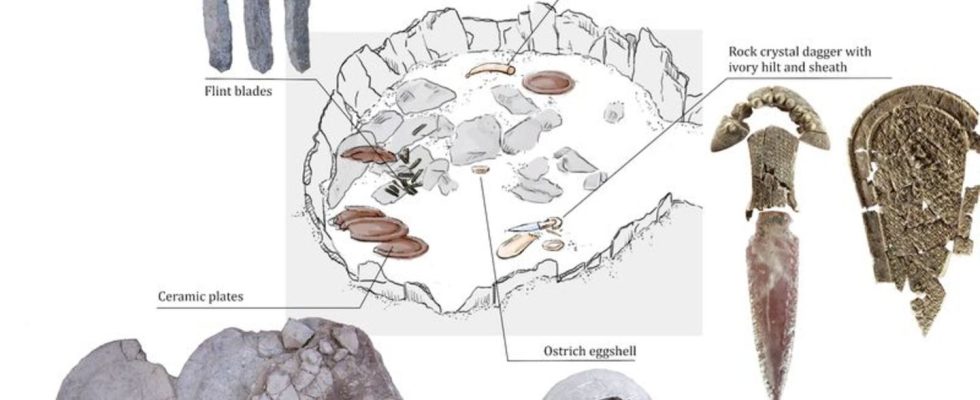Spain
Grave find: The supposedly male leader was a woman
An illustration depicting where certain grave goods were found during the excavation of a tomb. photo
© Austrian Academy of Sciences/dpa
When a grave from the Copper Age with valuable objects is discovered in Andalusia, it immediately becomes clear: It must be a man, because socially high-ranking people were always men – right?
Amber beads, rock crystals, ivory. When in 2008 in a millennia-old burial site in When such treasures were found in southern Spain, researchers naturally assumed that it must be a man who was buried here.
But now analyzes of a tooth from the magnificent tomb in Valencina near Seville in Andalusia show that it is not a leader who was buried there. It is a – possibly socially high – woman, as a research team reports in the journal “Nature Scientific Reports”.
So far, researchers had therefore assumed a 17 to 25-year-old man. The tomb dates from the Copper Age around 3200 to 2200 BC. “Frequently, images dominate that in the earliest epoch of human history all management positions were occupied by men,” said Katharina Rebay-Salisbury from the Austrian Archaeological Institute of the Austrian Academy of Sciences (ÖAW) and the University of Vienna. “This find throws a lot of our gender stereotypes overboard.”
The proof was achieved by means of a special analysis of the tooth enamel, which was developed and carried out in Vienna. “The result of such an analysis is 99.9 percent certain,” said Rebay-Salisbury. According to the team, among the many high-quality grave goods were an elephant tusk, ostrich egg shells and a dagger with a rock crystal blade and ivory handle, decorated with 90 disc-shaped mother-of-pearl beads.
Ivory Merchant or Priestess?
The authors of the study are convinced that the fact that such things were given to a woman in her grave shows that management positions may have been occupied by women even in the earliest epoch of human history. Rebay-Salisbury suspects that the buried woman may have been an ivory dealer or a priestess.
So far, no tomb of a man from the Copper Age has been found anywhere in Spain whose social status corresponds to that of the woman named the Ivory Lady, explained the Spanish archaeologist Marta Cintas Peña from the University of Seville. The only comparable grave is also on the burial ground near Valencina and contains the bones of at least 15 other women who lived after the Ivory Lady. Possibly they are people who have a connection with their lives – for example of a religious nature.
Overall, the results indicated that women may have held leadership positions in Copper Age Iberian society and that the role of women in the past and in processes of societal change should be reconsidered, the University of Seville said in a statement on the study.

